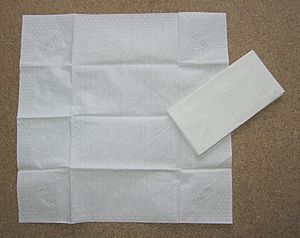Tissue paper facts for kids
Tissue paper or simply tissue is a very light and soft type of paper. It's mainly used for personal hygiene, like wiping your nose, or for cleaning. It's designed to be absorbent, which means it can soak up liquids easily. You'll find it in many forms, from the rolls in your bathroom to the boxes of tissues on your desk.
Contents
What is Tissue Paper Made From?
Tissue paper is usually made from wood pulp, which comes from trees. Sometimes, it's also made from recycled paper.
- Wood Pulp: This is the main ingredient. Trees like pine and spruce are often used. The wood is processed to separate the fibers.
- Recycled Paper: To be more eco-friendly, some tissue paper is made from old paper that has been collected and cleaned. This helps save trees and reduces waste.
- Water and Chemicals: A lot of water is used in the process to mix with the pulp. Safe chemicals are added to help break down the wood fibers and make the paper strong but soft.
How is Tissue Paper Made?
Making tissue paper involves several steps in large factories.
From Trees to Pulp
First, logs from trees are brought to the factory. Machines remove the bark, and then the wood is chipped into small pieces. These wood chips are cooked with chemicals and water in a big container called a digester. This process separates the wood fibers, creating a watery mixture called pulp.
Forming the Paper
The pulp is then cleaned and sometimes bleached to make it white. It's then spread very thinly onto a fast-moving mesh screen. Water drains away, leaving a thin layer of wet paper fibers. This wet sheet is then pressed and dried over heated rollers.
Softening and Finishing
To make the tissue paper soft, it often goes through a process called "creping." This involves scraping the paper off a large drying cylinder with a special blade, which crinkles the paper slightly and makes it feel softer. Finally, the large rolls of tissue paper are cut into smaller rolls or sheets, ready to be packaged into products like toilet paper, paper towels, or facial tissues.
Different Kinds of Tissue Paper
Tissue paper comes in many forms, each designed for a specific use.
- Facial Tissues: These are soft, absorbent sheets used for wiping noses or cleaning up small spills. They often come in boxes and are sometimes treated with lotions to be gentle on skin.
- Toilet Paper: This is a very common type of tissue paper, used for personal hygiene in bathrooms. It's designed to break down easily in water, which helps prevent plumbing problems.
- Paper Towels: These are stronger and more absorbent than facial tissues, designed for cleaning up spills in the kitchen or around the house. They are often textured to help scrub surfaces.
- Napkins: Used at meal times to wipe mouths and hands. They can be simple paper squares or more decorative for special occasions.
- Wrapping Tissue: This is a very thin, delicate type of tissue paper often used for wrapping gifts or protecting fragile items. It comes in many colors.
History of Tissue Paper
People have used different materials for hygiene for thousands of years, from leaves to cloth. Modern tissue paper as we know it is a more recent invention.
- Early Uses: In ancient China, paper was used for hygiene as early as the 6th century.
- Modern Development: The idea of mass-producing soft paper for personal use really took off in the late 19th and early 20th centuries. Companies started making facial tissues and toilet paper widely available. For example, the Scott Paper Company began selling toilet paper on rolls in 1890.
- Growth in Popularity: During the 20th century, as manufacturing improved and people became more focused on hygiene, tissue paper products became a common item in homes around the world.
Images for kids
See also
 In Spanish: Papel tisú para niños
In Spanish: Papel tisú para niños





